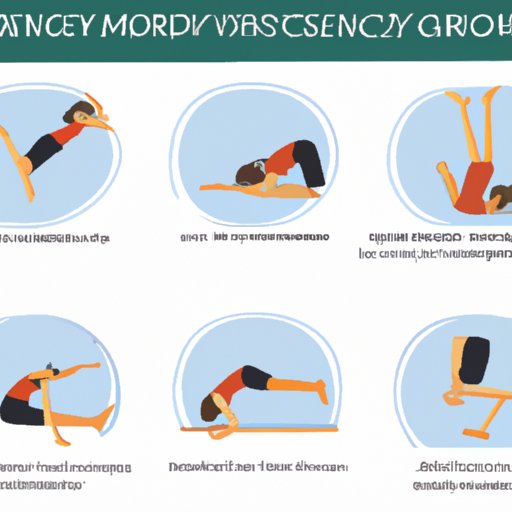
I. Introduction
Vertigo is a common symptom that affects many people. It causes a spinning sensation that can lead to dizziness, feelings of nausea, and unsteadiness. Vertigo can be caused by a number of things, including inner ear problems, head injuries, and medication. While medical intervention may be necessary for some cases of vertigo, there are several effective home remedies that can help alleviate symptoms.
II. Home Remedies for Vertigo: Natural Ways to Alleviate Dizziness
When it comes to treating vertigo at home, natural remedies can be an effective option. These remedies work by reducing inflammation, promoting circulation, and restoring balance. Some common ways to alleviate the symptoms of vertigo at home include:
Exercises to reduce vertigo symptoms
There are specific exercises that can help reduce the symptoms of vertigo. One of the most effective exercises is the Brandt-Daroff exercise, which involves moving from a lying-down position to a sitting position in a slow and controlled manner. This helps the body adjust to changes in position and can restore balance.
Changes in diet
Certain foods and drinks can contribute to vertigo, so making changes to your diet may be necessary to alleviate symptoms. Some people find that reducing their salt intake can help, as excessive salt can increase fluid retention in the body. Drinking plenty of water and staying hydrated can also help alleviate vertigo symptoms.
Using essential oils for relief
Essential oils like peppermint and lavender can help alleviate symptoms of vertigo. Peppermint is known for its anti-inflammatory properties and can help reduce dizziness, while lavender can help promote relaxation and reduce stress.
III. Vertigo Relief: Quick Fixes for Vertigo
There are certain practical solutions that can be employed to quickly reduce the onset of vertigo. These include:
Lying down to relieve symptoms
When experiencing the symptoms of vertigo, lying down may provide relief. This can help reduce the spinning sensation and promote feelings of calm and relaxation.
Taking deep breaths
Deep breathing can help reduce anxiety and stress, which can exacerbate feelings of dizziness and vertigo. Taking a few deep breaths can help calm the body and promote relaxation.
Focusing on a stationary object to reduce dizziness
When feeling dizzy or disoriented due to vertigo, focusing on a stationary object can help reduce symptoms. This can help the body reorient itself and restore balance.
IV. Yoga Poses for Vertigo: How to Rebalance Your Inner Ear
Yoga can be an effective way to reduce vertigo symptoms, as it promotes relaxation and helps restore balance to the body. Specific yoga poses and breathing exercises that can help alleviate vertigo symptoms include:
Child’s pose
Child’s pose can help reduce stress and promote relaxation throughout the body. This pose involves kneeling on all fours and then lowering the hips towards the heels, with the arms extended forward.
Mountain pose
Mountain pose can help promote balance and stability. It involves standing with your feet hip-width apart and your arms at your sides, while focusing on your breath and grounding yourself in the present moment.
Pranayama breathing
Pranayama breathing exercises can help promote relaxation and reduce stress, which can exacerbate feelings of dizziness and vertigo. One example of a simple breathing exercise is alternate nostril breathing, which involves closing one nostril and inhaling through the other, then exhaling through the opposite nostril.
V. How to Manage Vertigo with Home-Based Physical Therapy
In addition to natural remedies and yoga, physical therapy exercises can also be useful for managing vertigo at home. Physical therapy can help address the root cause of vertigo by addressing issues related to the vestibular system, which is responsible for balance and spatial orientation. Some physical therapy exercises that may be recommended for managing vertigo at home include:
Gaze stabilization exercises
These exercises involve focusing on a stationary object while moving the head side to side, up and down, and diagonally. This helps train the brain to respond appropriately to changes in head position.
Balance exercises
Balance exercises can help improve coordination and stability. Examples include standing on one leg, walking in a straight line, and practicing Tai Chi or other balance-focused activities.
VI. The Best Foods for Vertigo: What to Eat to Stop the Spinning Sensation
In addition to home remedies and physical therapy, good nutrition can also play a role in preventing vertigo. Certain foods and supplements can help promote inner ear health and reduce inflammation, which can help alleviate vertigo symptoms. Some of the best foods to eat for vertigo include:
Ginger
Ginger has anti-inflammatory properties and can help reduce nausea and dizziness. It can be consumed in various forms, such as tea, supplements, or fresh ginger root.
Peppermint
Peppermint has a cooling effect and can help reduce inflammation and dizziness. It can be consumed in the form of tea, supplements, or essential oil.
Vitamin D
Vitamin D is important for inner ear health and can help reduce inflammation and vertigo symptoms. It can be obtained through sunlight exposure or by taking supplements.
VII. Conclusion
Vertigo can be a challenging and uncomfortable symptom, but there are many ways to treat it at home. Natural remedies like exercise, essential oils, and dietary changes can be effective in reducing symptoms, as can quick fixes like lying down and deep breathing. Yoga and physical therapy can also promote balance and alleviate vertigo symptoms. Eating a healthy diet that includes foods like ginger, peppermint, and Vitamin D can help prevent vertigo from occurring. However, if vertigo persists, it is important to seek medical advice to determine the underlying cause and develop a treatment plan.




